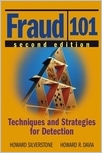| |||||
• polskie
• Zamów informacje o nowościach z wybranego tematu • kontakt |
FRAUD 101 TECHNIQUES AND STRATEGIES FOR DETECTIONDAVIA H.wydawnictwo: WILEY, 2005, wydanie IIcena netto: Unique insights into the nature of fraud and how to expose it It's not enough to wait for a tip to expose corporate fraud. Fraud 101, Second Edition provides step-by-step guidance on how to perform detection procedures for every major type of fraud. Its new and detailed case studies reveal how easy it can be for a perpetrator to commit a fraud and how difficult it can be to prosecute. This new edition also offers expanded coverage of financial statement fraud, fraud-specific internal control, and Sarbanes-Oxley. HOWARD M. SILVERSTONE, CPA, FCA, CFE, is founder and Director of Forensic Resolutions, Inc., a forensic accounting firm. He has concentrated on forensic and investigative accounting since 1985 and has been involved in all aspects of cases, including those involving fraud investigations, complex commercial litigation, insurance claims, and due diligence, both as a consulting and expert witness. He is also coauthor of Forensic Accounting and Fraud Investigation for Non-Experts (published by Wiley) and has contributed articles to The Legal Intelligencer, Security Management, and many other publications. He also contributed a chapter to The CPA's Handbook of Fraud and Commercial Crime Prevention, originally published in 2000 by the AICPA. He is a frequent speaker who has delivered presentations for professional organizations, law firms, and insurance companies. HOWARD R. DAVIA (deceased) was a certified public accountant with more than thirty years of experience in government, industry, and public accounting. As an audit executive with both the U.S. General Accounting Office and the General Services Administration, and subsequently as a chief executive operating officer with the General Services Administration, he gained vast experience in the opportunities for fraud, as well as for its detection and deterrence. He is the author of Fraud 101 and coauthor of Accountant's Guide to Fraud Detection and Control, Second Edition (published by Wiley). Contents Introduction. 1. The World of Fraud. Who Commits Fraud and Why? 2. Fraud Combatants. Fraud Company Profile (1987-1997). 3. Sarbanes-Oxley and Its Influence on Fraud Prevention. Audit Committee. 4. Proactive Fraud Investigations: An Introduction. Fraud Investigations Defined. 5. Proactive Fraud Investigations: Conducting the Investigation. Art of Fishing. 6. Elementary Fraud Types. Three Elementary Fraud Types: Definitions. 7. Fraud Defectives. Defective Delivery Fraud. 8. Contract Rigging Fraud. Definition. 9. Ethical Behavior. Accounting Ethical Standards. 10. Evidence. Indicative Evidence. 11. Symptomatic Fraud Investigation. Symptoms of Fraud. 12. Fraud Investigation Alternatives. Monitoring Known or Suspected Fraud. APPENDIX A: Anatomy of a Corporate Fraud. Hardcover, 238 pages
Po otrzymaniu zamówienia poinformujemy pocztą e-mail lub telefonicznie, |


